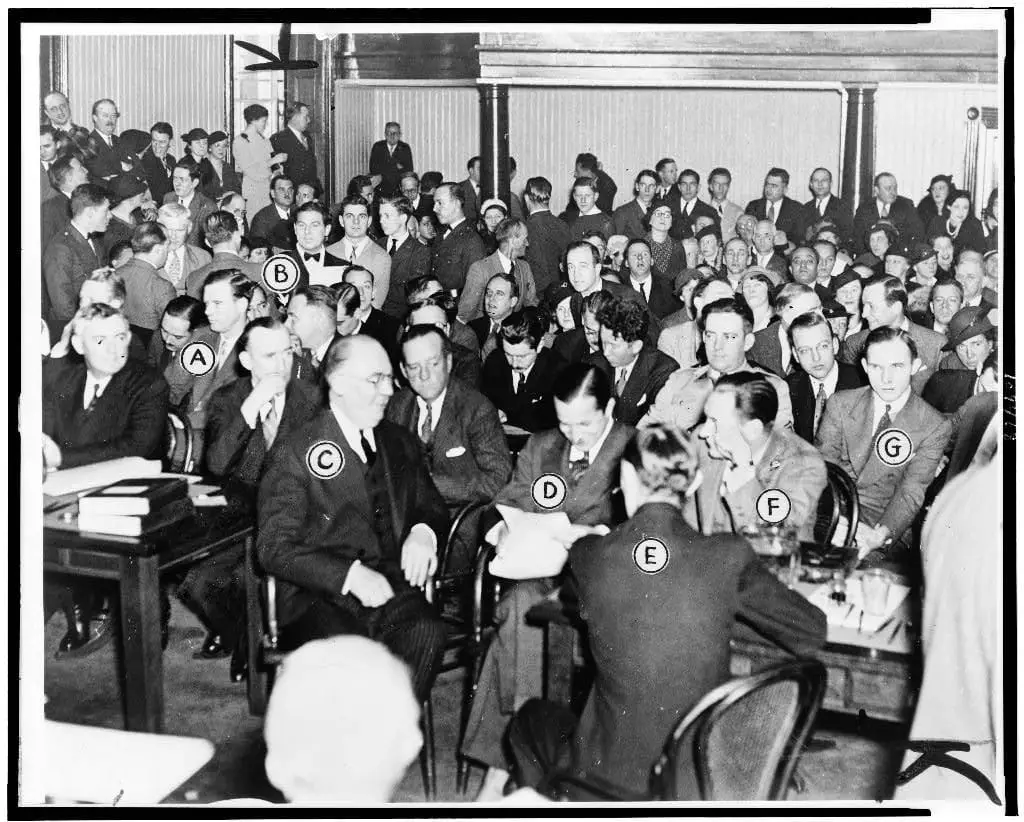The Detroit-born “Lone Eagle” aka, Charles Lindbergh’s 20-month-old son was kidnapped on March 1, 1932. The news shocked and gripped the entire nation, with updates occurring almost every week in newspapers, including the Harbor Beach Times. On March 11th, the Times printed its first update.
“Any news except that concerning the Lindbergh child Is – not news at this writing. The head of a great nation might die, any extraordinary event might occur, nothing could take the public’s attention; its tense, pitiful interest from the Lindbergh kidnapping.
That fact is a tribute to human nature and the soundness of its institutions. The family is the foundation of society. All civilization is built upon it, And this is a most horribly outrageous invasion of the sanctity of the family that makes every other conceivable happening: seem unimportant. Life, family, children are are not safe under our gangster rule.”
A month later, a $50,000 ransom was paid with the assurance that his child would be safe.
Featured Image – Charles A. Lindbergh is shown on the witness stand in the courtroom at Flemington as he tells his dramatic story of the night of March 1, 1932.
The Lindbergh Child is Recovered
On May 20th, the Harbor Beach Times printed the following update on page one.
“The Lindbergh child has been found dead in the Sourland Hills of New Jersey not far from the Lindbergh home. The child had been brutally murdered and been dead for about two months. No more dreadfully shocking news could be more imagined, nothing can produce great a horror of the depth of criminality to which this nation has been reduced.
Yet the dreadful end of a horrible tragedy will be for the unhappy parents almost a relief from the uncertainty, the constant wondering and worry about the child day after day and into the dreadful night. It means the end of the agony that has lasted week after week for so long. It means above all that the little boy is forever beyond the reach of man’s hideous brutality. His spirit is set free; nothing more can ever harm him now. His parents must find whatever comfort they can in that thought and in the profound sympathy of an entire nation.”
Fall Of 1933 – The Press Resorts to Consulting with Mobster Al Capone
On October 27th, 1933, that had been little development to solving the case. After that, however, speculation was rampant that the kidnapping was the work of organized crime. So the Times offered this tidbit of development front the case.
“An able police official of Chicago, who worked on the horrible Leopold murder, believes that Colonel Lindbergh s child was abducted ‘ and murdered by one or more deprived students in a stunt crime.
Mr. Capone told this writer, who visited him In the Chicago prison, “The Lindbergh, baby was not’ abducted by any regular mob. They wouldn’t be so foolish. That was the work of some crazy fool working by himself.”
Bruno Hauptmann was caught in September 1934 for the crime after spending one of the ransom money notes at a gas station. His garage contained $14,600 of the ransom money. Hauptmann stated that the money was given to him by his old business partner, who had returned to Germany and died on March 29, 1934. A search of Hauptmann’s residence turned up further evidence related to the crime.
Trial for the Kidnap Crime of the Century

The Hauptman trial was due to start in early 1935. On January 4th, the Times gave this update.
“Prosecution and defense attorneys completed their preparations for the trial of Bruno Hauptmann on the charge of murdering the Lindbergh baby and the little town of Flemington,
NJ was a busy place. The names of 48 veniremen were drawn for examination as Jurors, and the sensation o of the mailing of a satire on the Lindbergh case to 150 prospective Jurors died down. C. Lloyd Fisher, defense counsel, said he would not ask for a new panel.
Betty Gow, the nurse’ who put the Lindbergh baby to bed the night he was kidnaped and killed, arrived from Scotland on the liner Aquitania and went at once to the Morrow home in Englewood, N. J., to await her call as one of the state’s star witnesses. She declined to talk to reporters but posed for cameramen. There was a report that Miss Gow might remain in the country and take up her former job in the Lindbergh household. She had acted as a nurse for Jon, the second son born to the Lindberghs until she returned to her home in Scotland several months ago.”
In 1936, Hauptmann was judged guilty of first-degree murder and executed by the electric chair. However, he maintained his innocence until the end, turning down a last-minute offer to shorten his sentence to life in prison without the possibility of release in return for a confession.
The Aftermath of the Lindbergh Kidnapping and Murder
The Lindbergh kidnapping and subsequent murder of the child shocked the nation. Those families in the public eye were particularly apprehensive about a copycat abduction of their children. No Michigan family was more in the public eye than the Henry Ford clan.
Edsel Ford, the only child of Henry Ford, began purchasing parcels of land in Highland and White Lake Townships in 1923. The plan was to construct a self-sufficient retreat as a diversion from the hustle and bustle of city life. This would be a more convenient retreat than a lengthy drive to northern Michigan.
The compound consisted of GateHouse, riding stables, barn, carriage house, (a three-car log garage with living quarters! However, the crown jewel was the 6,900 square foot hilltop lodge with a swimming pool and tennis court. Today that entire estate is part of the Highland Recreation Area.
The area was remote, isolated, and patrolled by the notorious Ford Motor Security headed by Henry Bennett. On a tour of the ground in the 1970s, I was told by a DNR ranger that Edsel’s family moved to the lodge and spent most of their time here in the 1930s as a result of the Lindburgh kidnapping.



